The Nakshatras and their asterisms

The 27 Nakshatras are the stations of the Moon, aka lunar mansions, that are evenly distributed along the sidereal zodiac that forms the basis of Vedic astrology.
The nakshatras have been introduced by the ancient Indian astronomers and astrologers. Each nakshatra (or lunar mansion, or station) is the part of the sky that the Moon covers during single day.
Since the nakshatras use the sidereal zodiac — meaning the real backdrop of physical fixed stars — each of them was assigned a particular group of stars, an asterism, that carries certain astrological symbolism.
The most accepted system of nakshatras consists of 27 equal divisions of the full 360º ecliptic circle and thus produces 27 equal segments of 13º20’ per nakshatra.
Each nakshatra is defined by a combination of:
- a segment along the ecliptic
- a corresponding asterism within that segment
A visual tour of the nakshatras
The best way to get the feeling of what the nakshatras actually are in the sky is to watch the animated tour along the ecliptic highlighting corresponding asterisms for each nakshatra. This way the reader will be able to identify those asterisms in the real sky and establish a deeper feeling for those sky segments.
The videos below should be watched in the HD (high definition) mode to enable legibility of text and fine starry sky details. Use the cogwheel icon at the bottom of the video to switch to the HD mode.
The two videos below present the nakshatras tour from both northern and southern hemispheres.
The two Moon cycles
There are two fundamental cycles of the Moon: sidereal orbital period and synodic month.
The shorter 27.27 day sidereal orbital period is the time it takes the Moon to complete its travel along the backdrop of the fixed stars. For example, if the Moon today were at fixed star Spica, it will take it 27.27 days to arrive at Spica again. The sidereal period reflects the alignment between the Moon and fixed stars. This cycle is the basis for defining the nakshatras.
The longer 29.5 day synodic month is the time from one New Moon to the next New Moon, aka the lunation cycle. The synodic period reflects the alignment between the Moon and the Sun.
The nakshatras are calculated using the sidereal orbital period and the sidereal zodiac.
How many nakshatras are there, 27 or 28?
A more “modern” system of 27 nakshatras — that is in fact more that 2,000 years old — uses the 365 days calendar with the Moon covering the arc of 13º20’ per day. This corresponds to the 27.27 day sidereal orbital period and produces the commonly accepted system of 27 nakshatras.
The older system of 28 nakshatras reflects the fact that in Vedic times the length of the year was considered to be 360 days with 12 perfect months of 30 days and the Moon was considered to travel exactly 13º per day. In that perfect but unfortunately imprecise system the sidereal orbital period was 27.69 days, meaning that it takes about 28 days for the Moon to complete the full circle along the ecliptic, hence 28 divisions of the ecliptic. The 360 day solar year was finally abandoned around 700 BCE.
Subdivisions of a nakshatra
Each nakshatra is further subdivided into four equal parts called the padas. Each pada is thus 3º20’.
Since one nakshatra corresponds to a segment of the sky travelled by the Moon in a single day, one may think of a pada as a quarter of a day, an approximate 6 hour period.
Symbolical associations of the padas can be conceptualised using the four fold model similar to the four quadrants of the astrological chart. The times are obviously approximate and symbolic in essence.
| Pada | Part of day | Symbolism | Moon phase |
|---|---|---|---|
| Pada 1 | Midnight to 6 hours | Spring, beginning | Waxing crescent |
| Pada 2 | 6 hours to noon | Summer, unfoldment | Waxing gibbous |
| Pada 3 | Noon to 18 hours | Autumn, fruition | Waning gibbous |
| Pada 4 | 18 hours to midnight | Winter, reconciliation | Waning crescent |
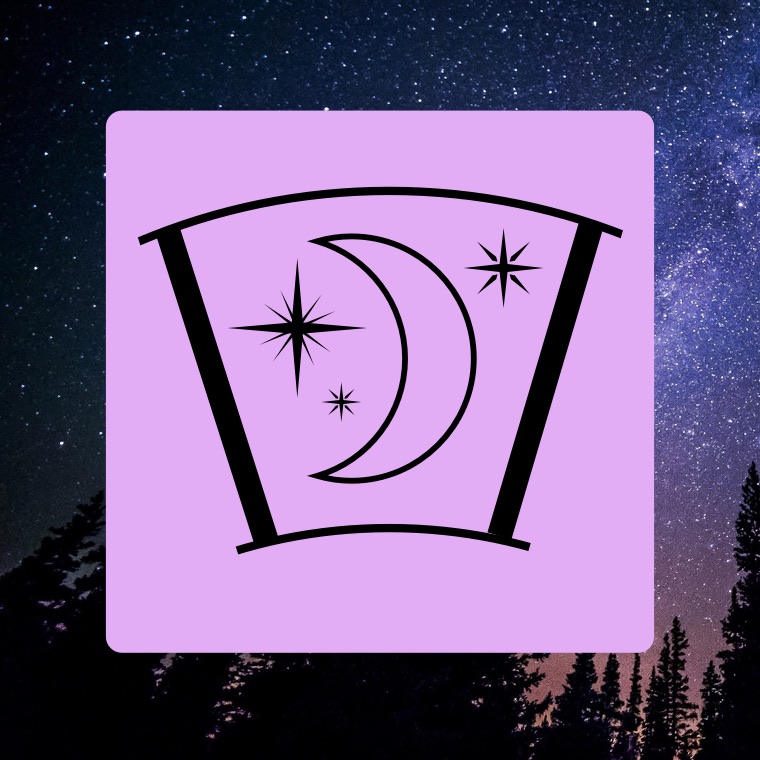
The Nakshatras calculator
Track the nakshatras (lunar mansions) of the Moon and other planets of astrological chart using a Home Screen widget and an app extension. Explore the add-on…
Perceiving the Nakshatras
The best way to experience the nakshatras is through direct observation of the night sky. The rest of this article will illustrate asterisms corresponding to each nakshatra and can serve as a guide for the reader to gain deeper familiarity with the prominent asterisms that constitute both the nakshatras and the zodiac signs, the foundations of astronomical constellations.
1. Ashvini | 2. Bharani | 3. Krittika | 4. Rohini | 5. Mrigashira | 6. Ardra | 7. Punarvasu | 8. Pushya | 9. Ashlesha | 10. Magha | 11. Purva Phalguni | 12. Uttara Phalguni | 13. Hasta | 14. Chitra | 15. Swati | 16. Vishakha | 17. Anuradha | 18. Jyeshtha | 19. Mula | 20. Purva Ashada | 21. Uttara Ashada | 22. Shravana | 23. Dhanishtha | 24. Shatabhisha | 25. Purva Bhadrapada | 26. Uttara Bhadrapada | 27. Revati
And not forgetting to say a few words about Abhijit that belongs to the non-standard archaic 28 Nakshatra system.
1. Ashvini
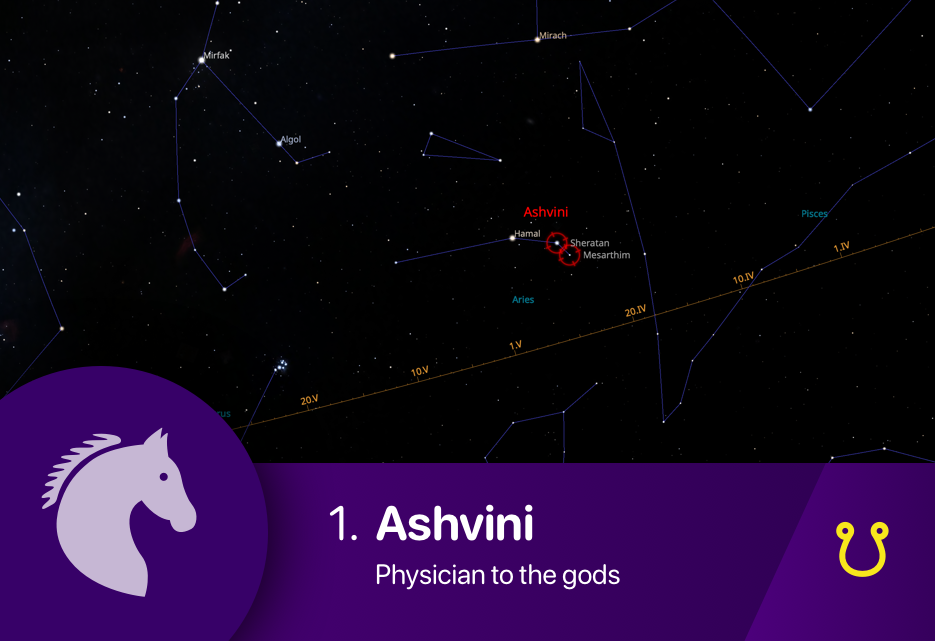
| Name | Physician to the gods |
| Ruler | Ketu (South Node) |
| Symbol | Horse’s head |
| Also | Transport, possessing horses, yoking horses |
| Deity | Ashvins, divine doctors |
| Sidereal | 0º – 13º20 Aries |
| Stars | β “Sheratan” and γ “Mesarthim” of Aries |
| Energy | South Node and Mars |
| Qualities | Dynamic, fiery, awakened, buoyant life energy, stamina, aggression |
2. Bharani
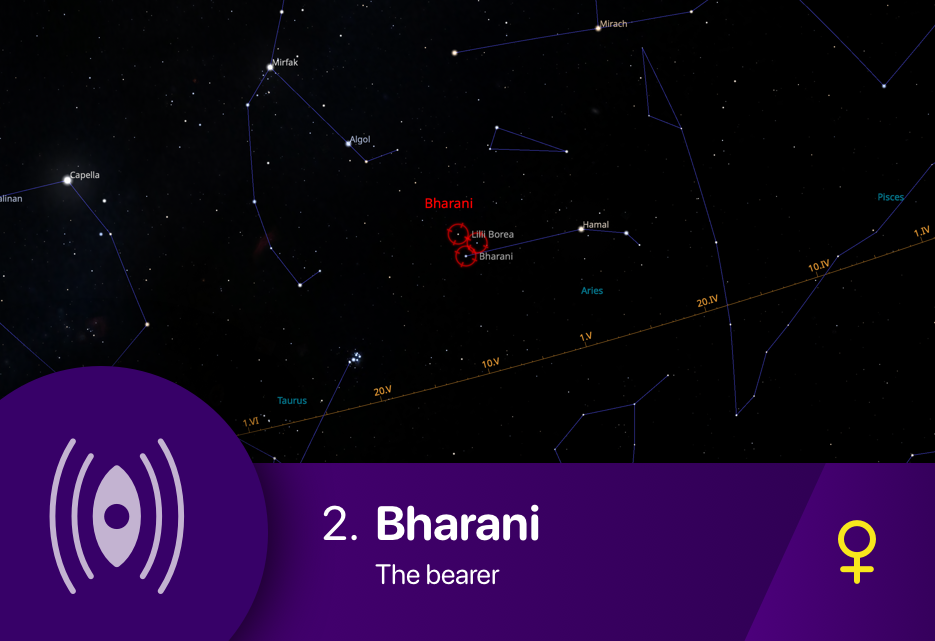
| Name | The bearer |
| Ruler | Venus |
| Symbol | Yoni (female reproductive organ) |
| Also | Restraint, bearing |
| Deity | Yama |
| Sidereal | 13º20 – 26º40 Aries |
| Stars | 35, 39 “Lilii Borea” and 41 “Bharani” of Aries |
| Energy | Venus and Mars |
| Qualities | Artistic, creative, responsibility, passion, excessive struggle and frustration |
3. Krittika
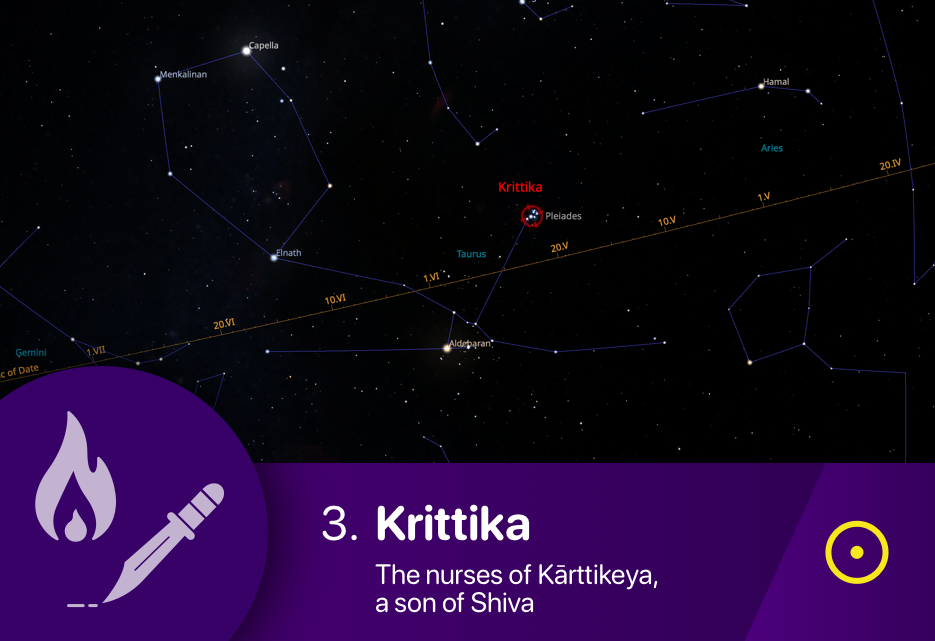
| Name | Nurses of Karttikeya, a son of Shiva |
| Ruler | Sun |
| Symbol | Flame, cutting edge |
| Also | Fire, cutters |
| Deity | Agni |
| Sidereal | 26º40 Aries – 10º Taurus |
| Stars | The Pleiades |
| Energy | Sun and Mars–Venus |
| Qualities | Greatness, truth, willpower, desires, despotism |
4. Rohini
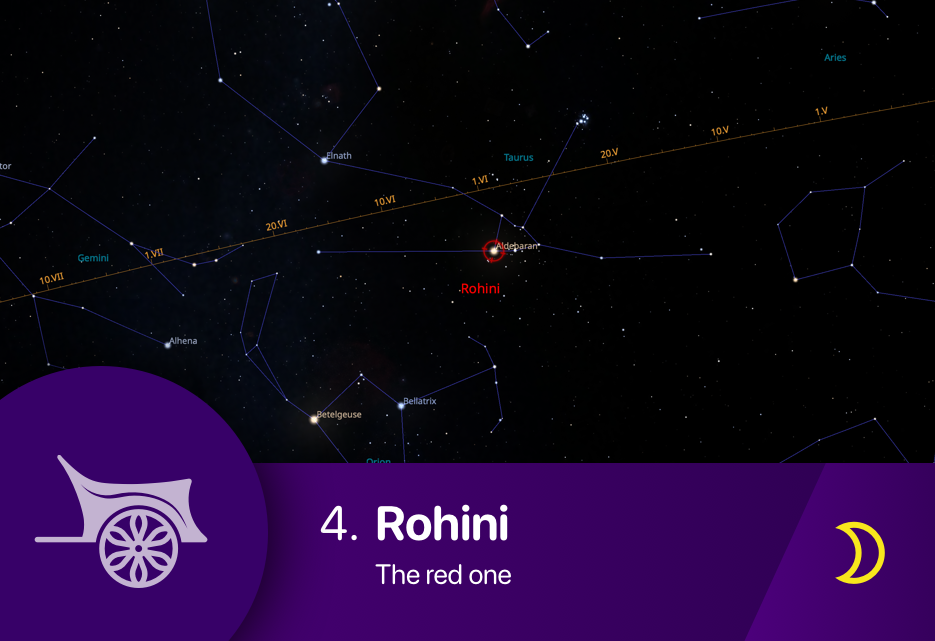
| Name | The red one |
| Ruler | Moon |
| Symbol | Chariot, temple, banyan tree |
| Also | Ruddy, growing, ascent |
| Deity | Brahma or Prajapati |
| Sidereal | 10º – 23º20 Taurus |
| Stars | Aldebaran of Taurus |
| Energy | Moon and Venus |
| Qualities | Charm, beauty, sensual, indulging, consumerism, earth-bound, heavy soul |
5. Mrigashira
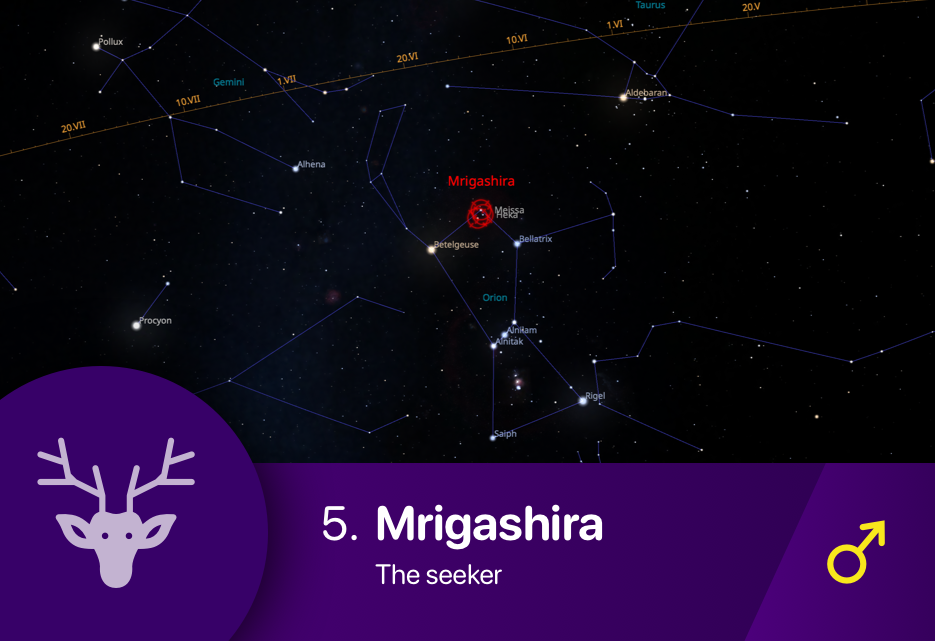
| Name | The seeker |
| Ruler | Mars |
| Symbol | Deer’s head |
| Also | Search, start of quest |
| Deity | Soma, Chandra |
| Sidereal | 23º20 Taurus – 6º40 Gemini |
| Stars | λ “Meissa”, φ “Hecka” of Orion |
| Energy | Mars and Venus–Mercury |
| Qualities | Quest for Spirit, subtle perceptions, curiosity, intelligence, erratic pursuits |
6. Ardra
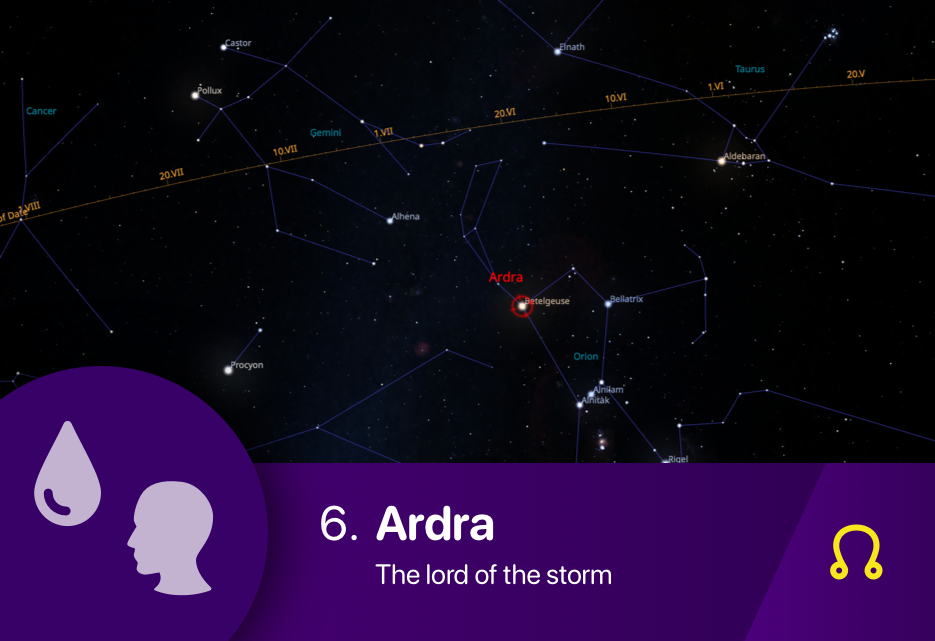
| Name | The lord of the storm |
| Ruler | Rahu (North Node) |
| Symbol | Human head, drop of water, diamond |
| Also | Shining gem, wet, soft, green, sharp |
| Deity | Rudra, the storm god |
| Sidereal | 6º40 – 20º Gemini |
| Stars | Betelgeuse or Orion |
| Energy | North Node and Mercury |
| Qualities | Intelligence, power of sharp mind, ungratefulness, abuse of power |
7. Punarvasu
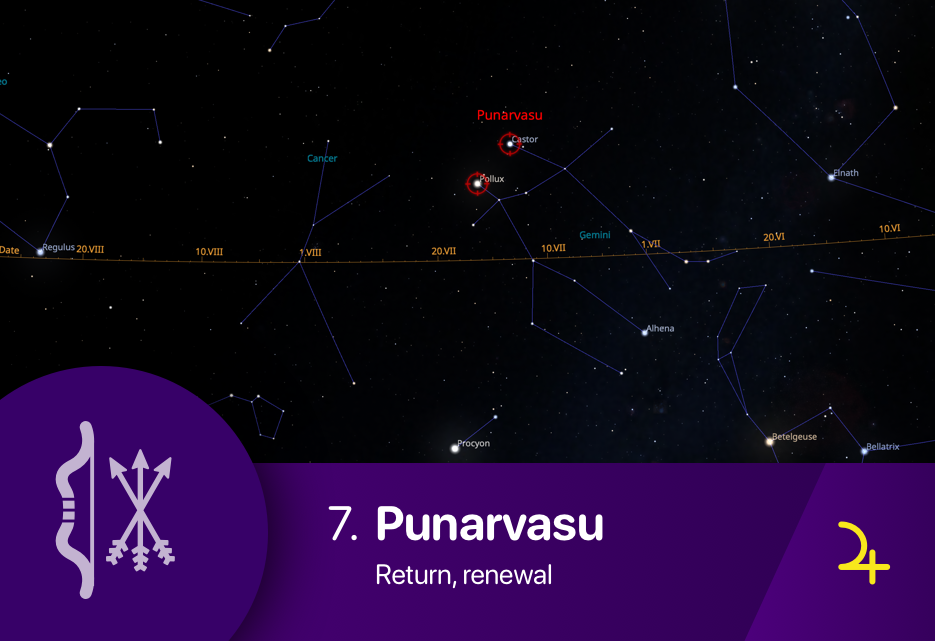
| Name | Return, renewal, restoration; good, brilliant |
| Ruler | Jupiter |
| Symbol | Bow and quiver of arrows |
| Also | Repetition, ray of light, jewel, prosperous |
| Deity | Aditi, mother of the gods |
| Sidereal | 20º Gemini – 3º20 Cancer |
| Stars | Castor and Pollux of Gemini |
| Energy | Jupiter and Mercury–Moon |
| Qualities | Generosity, purity, launching pad to success, mobility, mental flimsiness |
8. Pushya
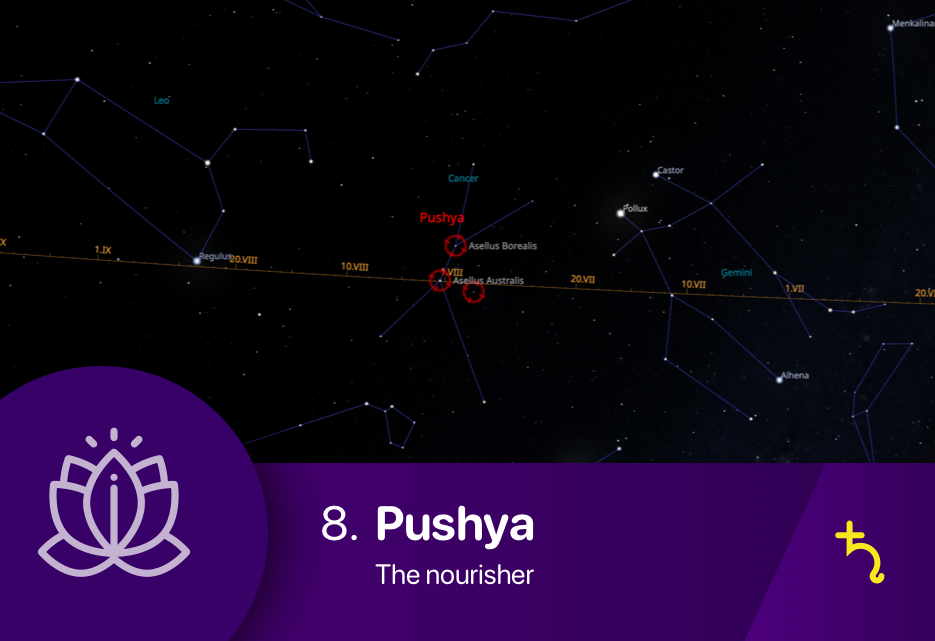
| Name | The nourisher |
| Ruler | Saturn |
| Symbol | Circle, lotus, cow’s udder |
| Also | Providing, nurturing, blossoming |
| Deity | Brihaspati, priest of the gods |
| Sidereal | 3º20 – 16º40 Cancer |
| Stars | γ “Asellus Borealis”, δ “Asellus Australis” and θ of Cancer |
| Energy | Saturn and Jupiter |
| Qualities | Wisdom, power of word, wisdom of higher knowledge, stubbornness, selfish |
9. Ashlesha
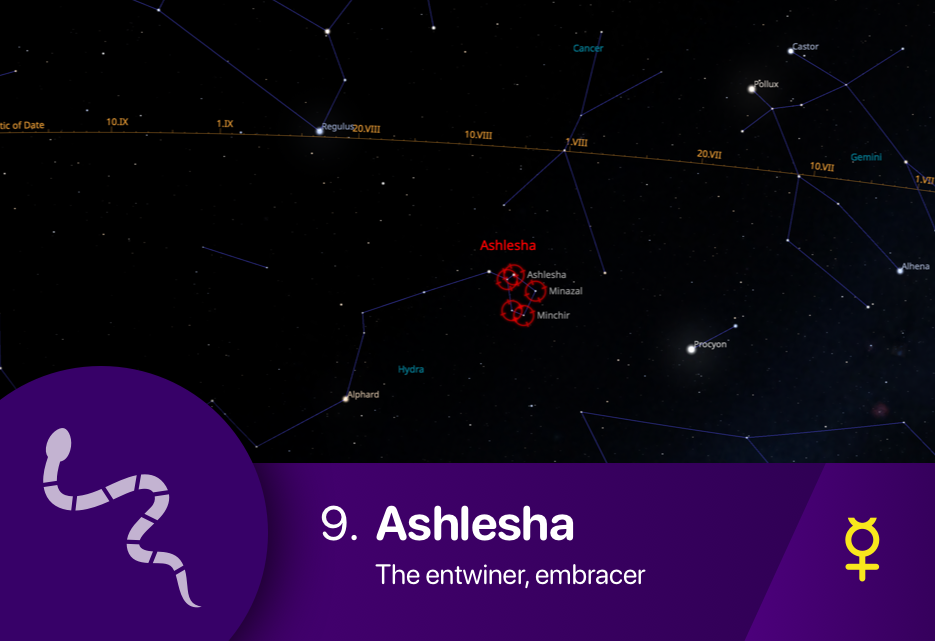
| Name | The entwiner, embracer |
| Ruler | Mercury |
| Symbol | Serpent |
| Also | Kundalini, entangling |
| Deity | Naga, the serpent king |
| Sidereal | 16º40 – 30º Cancer |
| Stars | δ, ε “Ashlesha Nakshatra”, η, ρ, and σ “Minchir” of Hydra |
| Energy | Mercury–Moon and Pluto, the Underworlds |
| Qualities | Deep, magnetic, thoughtful, reclusive, sensual, depression, melancholy, elusiveness |
10. Magha
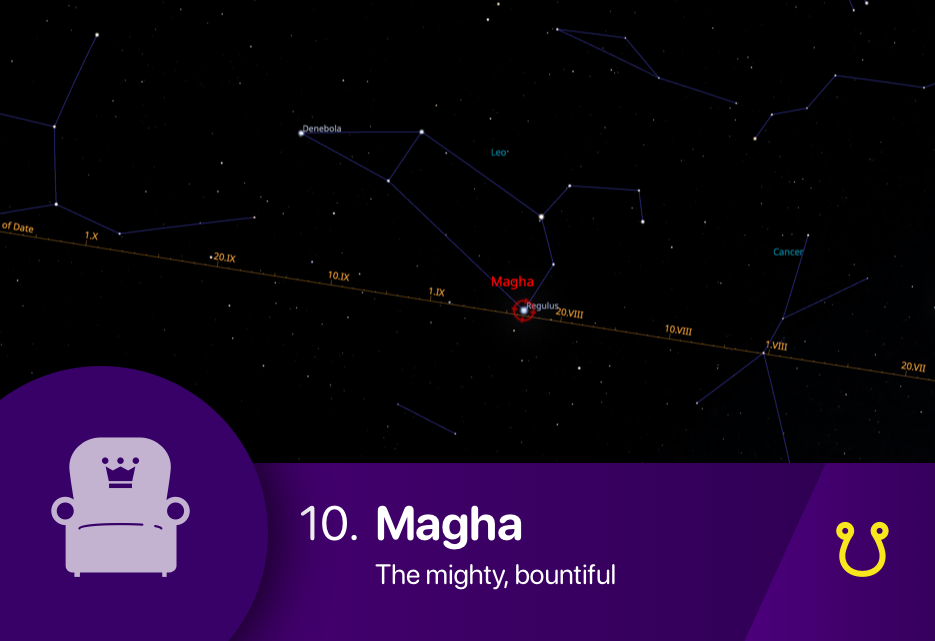
| Name | The mighty, bountiful |
| Ruler | Ketu (South Node) |
| Symbol | Royal throne |
| Also | Great |
| Deity | Pitras, protectors of humanity |
| Sidereal | 0º – 13º20 Leo |
| Stars | Regulus |
| Energy | South Node and Sun |
| Qualities | Heartness, spirituality, leadership, ambition, pride, arrogance |
11. Purva Phalguni
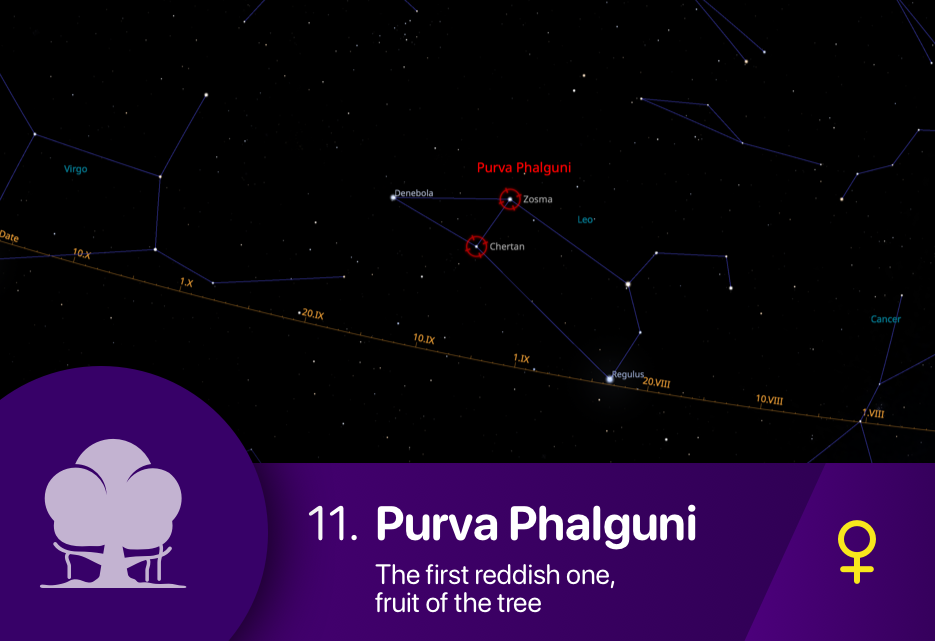
| Name | The first reddish one, fruit of the tree |
| Ruler | Venus |
| Symbol | Fig tree, hammock, couch |
| Also | Recuperation, prosperity, well-being, enjoyments |
| Deity | Bhaga, the god of good fortune |
| Sidereal | 13º20 – 26º40 Leo |
| Stars | δ “Zosma” and θ “Chertan” of Leo |
| Energy | Venus and Sun |
| Qualities | Love, creativity, art, procreation, wealth, pleasure, self indulgence, vanity |
12. Uttara Phalguni
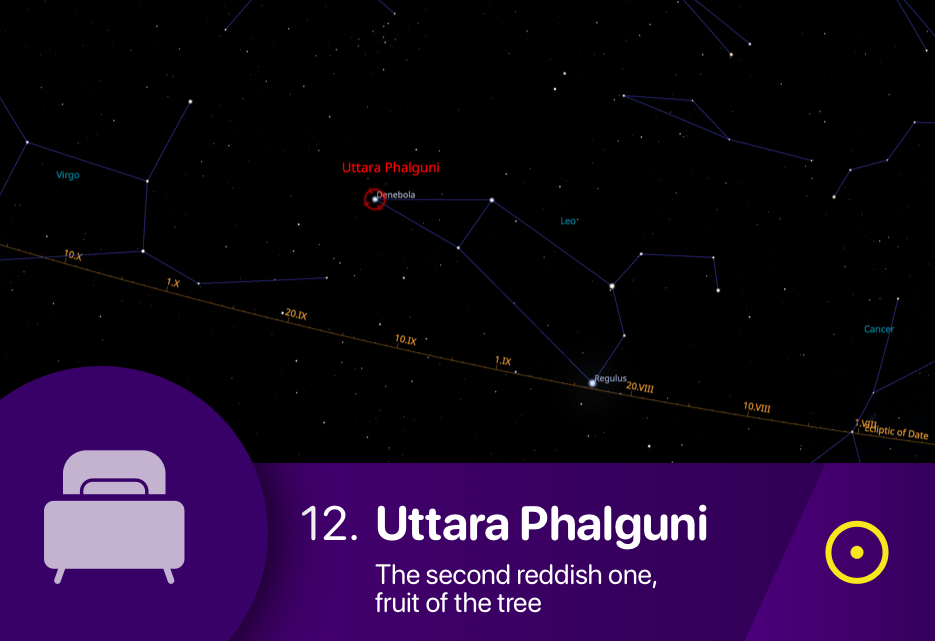
| Name | The second reddish one, fruit of the tree |
| Ruler | Sun |
| Symbol | Hammock, rear legs of bed |
| Also | Patronage, friendship, leadership, nobility, caring |
| Deity | Aryaman, god of patronage |
| Sidereal | 26º40 Leo – 10º Virgo |
| Stars | Denebola of Leo |
| Energy | Sun and Mercury |
| Qualities | Expansion, caring, healing, helping, enduring, seeking for lost half, abandonment, stubbornness, resentment |
13. Hasta
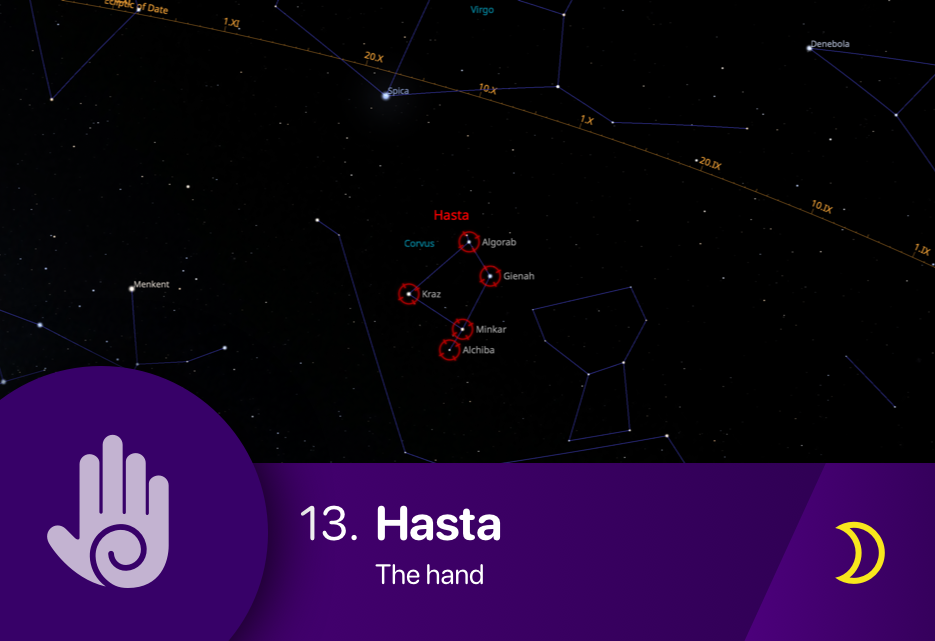
| Name | The hand |
| Ruler | Moon |
| Symbol | Palm of the hand |
| Also | Blessings |
| Deity | Savitar, the Sun god |
| Sidereal | 10º – 23º20 Virgo |
| Stars | α “Alchiba”, β “Kraz”, γ, δ “Algorab” and ε “Minkar” of Corvus |
| Energy | Moon and Mercury |
| Qualities | Clarity of thinking, creative and structured intelligence, humorous, self-development, ascetic tendencies, fragile health, stress, lack of patience, cold and calculating |
14. Chitra
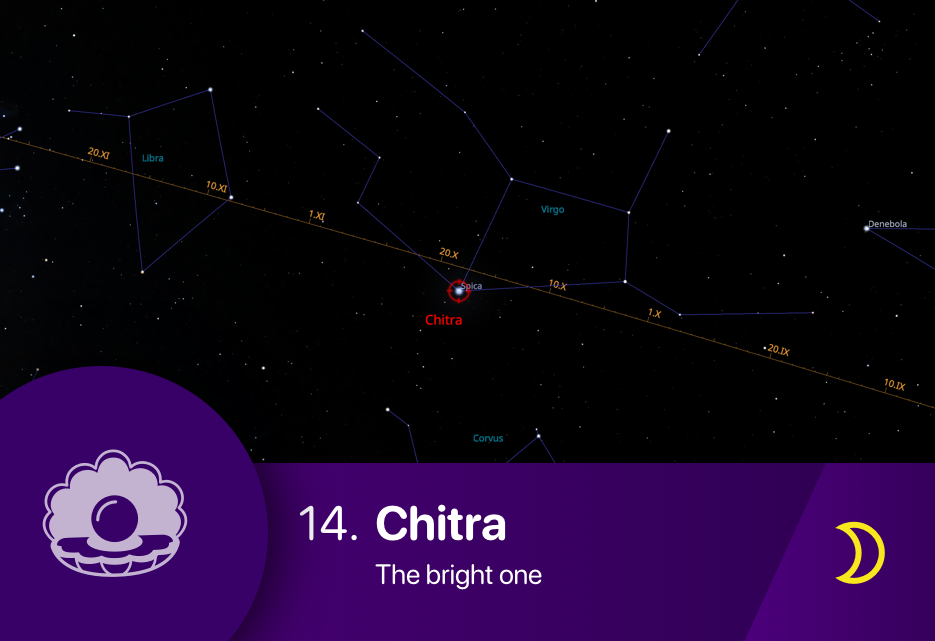
| Name | The bright one |
| Ruler | Mars |
| Symbol | Bright jewel or pearl |
| Also | Opportunity, brilliant, beautiful |
| Deity | Tvashtar, the celestial architect |
| Sidereal | 23º20 Virgo – 6º40 Libra |
| Stars | Spica of Virgo |
| Energy | Mars and Mercury–Venus |
| Qualities | Artistic, charismatic, charming, bright, prosperous, illusory, seductive, self-consciousness, egotism |
15. Swati
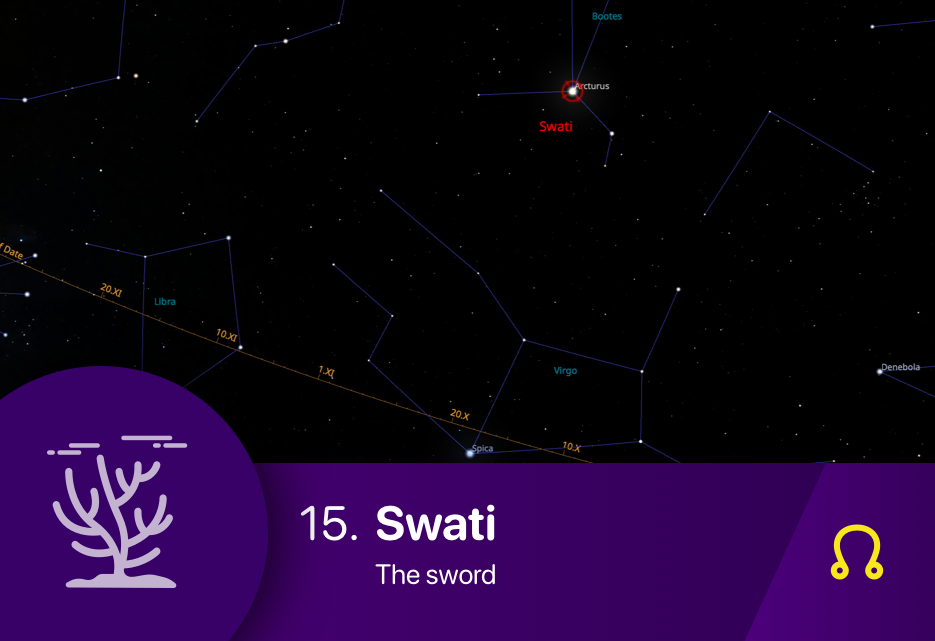
| Name | The sword |
| Ruler | Rahu (North Node) |
| Symbol | Coral |
| Also | Independence, self-going |
| Deity | Vayu, the wind demigod |
| Sidereal | 6º40 – 20º Libra |
| Stars | Arcturus of Boötes |
| Energy | North Node and Venus–Saturn in air modality |
| Qualities | Survival through movement and adjustment, sensitivity, communication, self-reliance, life- and world-oriented, materialistic |
16. Vishakha
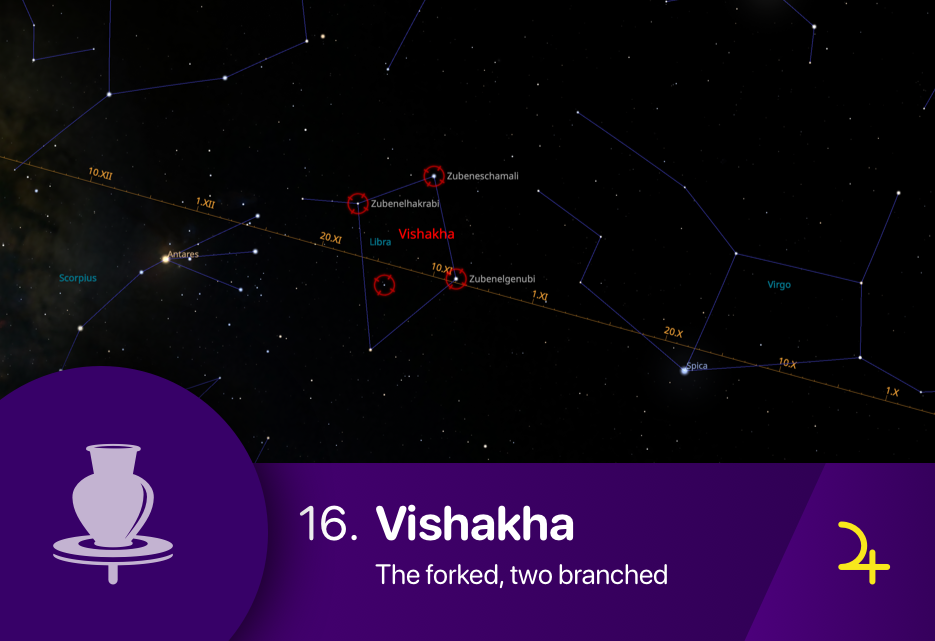
| Name | The forked, two branched |
| Ruler | Jupiter |
| Symbol | Triumphal arch, potter’s wheel |
| Also | Success, delight |
| Deity | Indra, chief of gods and Agni, god of fire |
| Sidereal | 20º Libra – 3º20 Scorpio |
| Stars | α “Zubenelgenubi”, β “Zubeneschamali”, γ “Zubenelhakrabi” and ι of Libra |
| Energy | Jupiter and Venus–Mars |
| Qualities | Optimism, enthusiasm, faith, hope, patience, persistence, courage, anger, envy, bitterness, dictatorial |
17. Anuradha
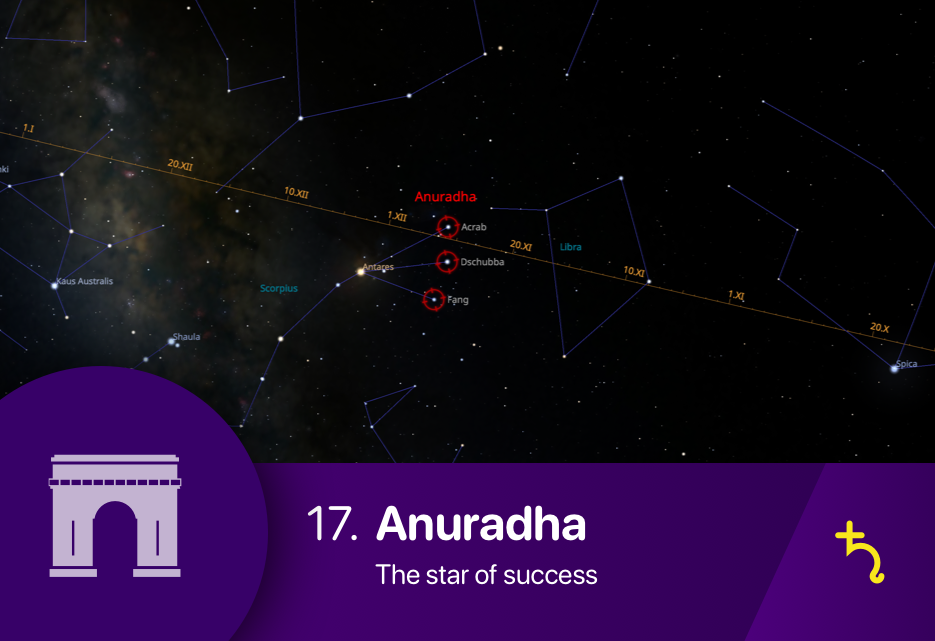
| Name | The star of success |
| Ruler | Saturn |
| Symbol | Triumphal archway, lotus |
| Also | Worship, divine service |
| Deity | Mitra, deity of friendship and partnership |
| Sidereal | 3º20 – 16º40 Scorpio |
| Stars | β “Acrab”, δ “Dschubba” and π “Fang” of Scorpius |
| Energy | Saturn and Mars–Pluto |
| Qualities | Knowledgeable organiser and collaborator, respect of peers, stability, fixation, melancholy, coldness, abuse of powers |
18. Jyeshtha
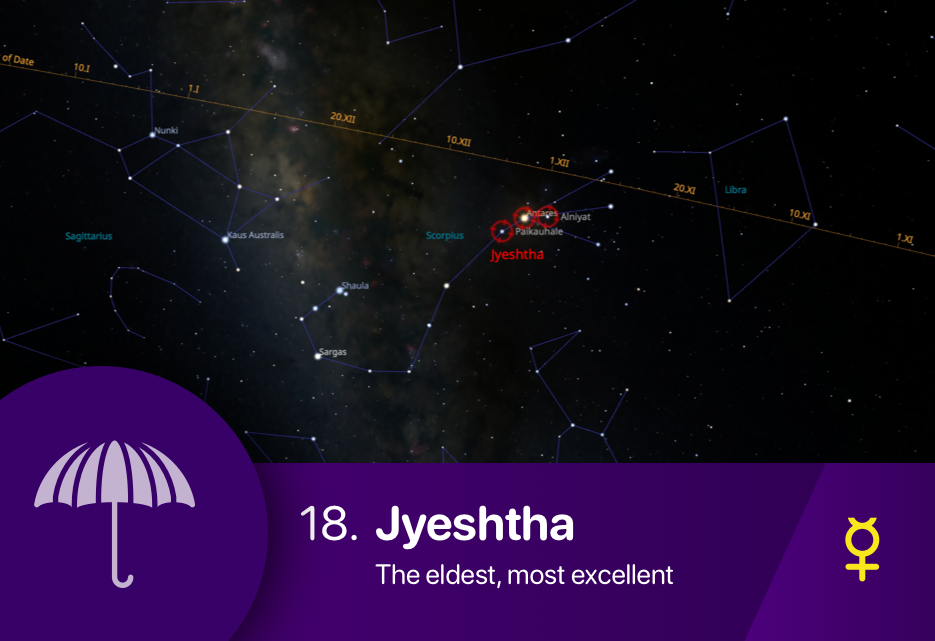
| Name | The eldest, most excellent |
| Ruler | Mercury |
| Symbol | Circular amulet, umbrella, earring |
| Also | Most senior, chief, eldest |
| Deity | Indra, chief of the gods |
| Sidereal | 16º40 – 30º Scorpio |
| Stars | α “Antares”, σ “Alniyat”, and τ “Paikauhale” of Scorpius |
| Energy | Mercury and Mars–Pluto |
| Qualities | Excellence in intelligence, penetrative mind, originality and flexibility, secretiveness, scheming, arrogant |
19. Mula
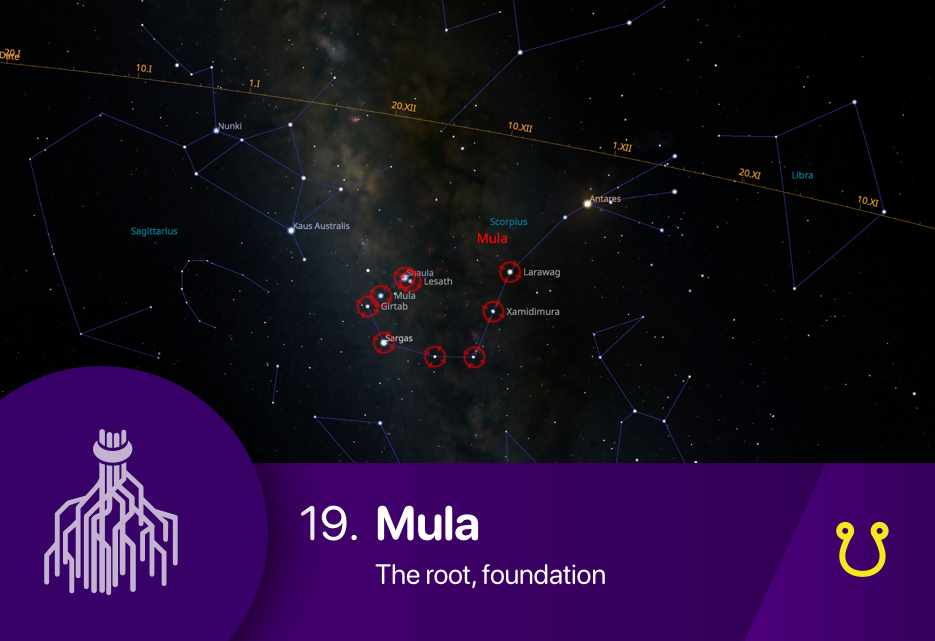
| Name | The root, foundation |
| Ruler | Ketu (South Node) |
| Symbol | Tied bunch of roots |
| Also | Tail of lion, foundation |
| Deity | Nirriti, goddess of dissolution and destruction |
| Sidereal | 0º – 13º20 Sagittarius |
| Stars | ε “Larawag”, ζ, η, θ “Sargas”, ι, κ, λ “Shaula”, μ and ν “Jabbah” of Scorpius |
| Energy | South Node and Pluto–Jupiter |
| Qualities | Philosophical, deep, mysterious, redemption, power of attraction, wealth and power, manipulation, destruction |
20. Purva Ashada
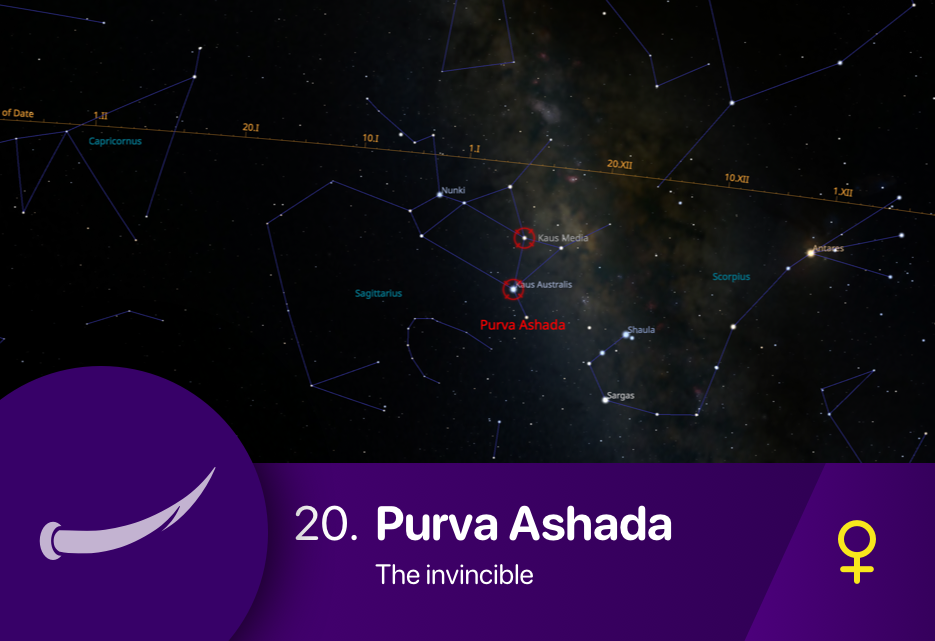
| Name | The invincible |
| Ruler | Venus |
| Symbol | Elephant tusk, basket |
| Also | Undefeated, unsubdued |
| Deity | Apas, god of water |
| Sidereal | 13º20 – 26º40 Sagittarius |
| Stars | δ “Kaus Media” and ε “Kaus Australis” of Sagittarius |
| Energy | Venus and Jupiter |
| Qualities | High priest or priestess, spiritual, philosophical, attractive, influential, independent, hubris, haughty, obstinate |
21. Uttara Ashada
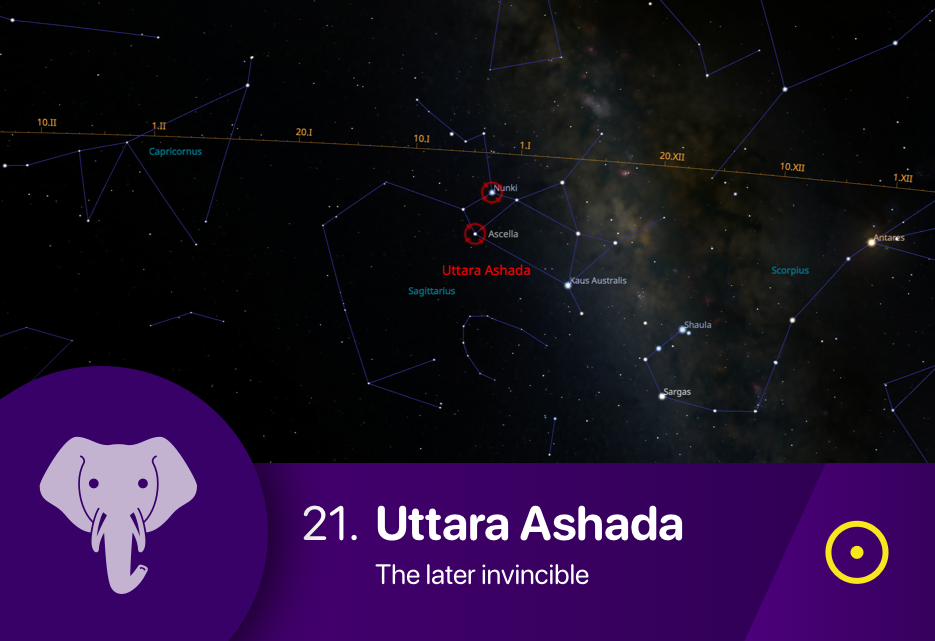
| Name | The later invincible |
| Ruler | Sun |
| Symbol | Elephant tusk, small bed |
| Also | Universal, for all humankind, victory after time passed |
| Deity | Vishvadevas, universal gods |
| Sidereal | 26º40 Sagittarius – 10º Capricorn |
| Stars | ζ “Ascella” and σ “Nunki” of Sagittarius |
| Energy | Sun and Jupiter |
| Qualities | Spiritual seeker, leadership, magnanimity, stability, centre of power, burn out, lack of motivation |
22. Shravana
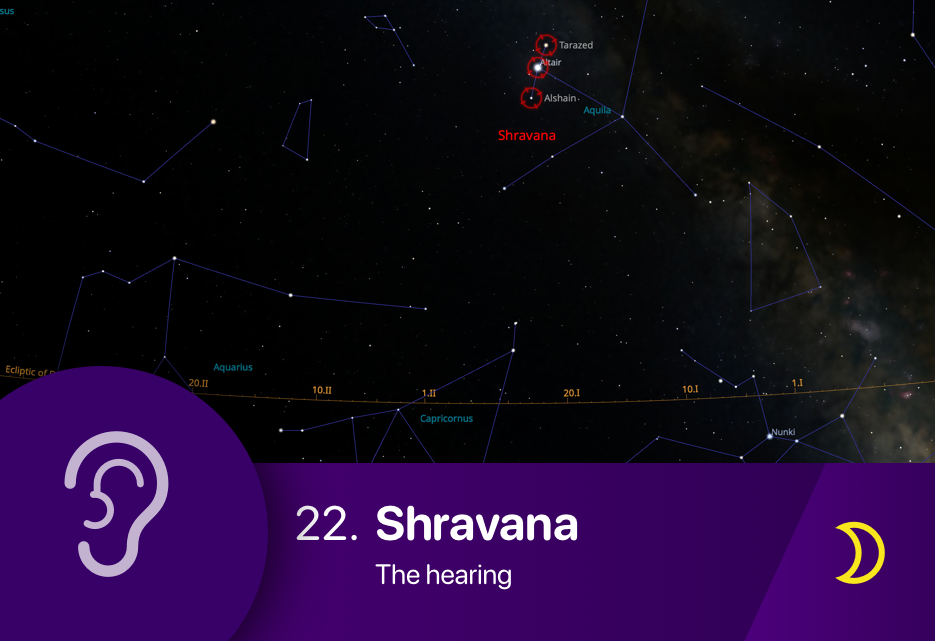
| Name | Hearing |
| Ruler | Moon |
| Symbol | Ear, three footprints |
| Also | Learning, knowledge, flow of consciousness |
| Deity | Vishnu, preserver of universe |
| Sidereal | 10º – 23º20 Capricorn |
| Stars | α “Altair”, β “Alshain” and γ “Tarazed” of Aquila |
| Energy | Moon and Saturn |
| Qualities | Receptive to the subtle, voice and communication, teaching and educating others, studying, seclusion, rigidity, suspicion |
23. Dhanishtha
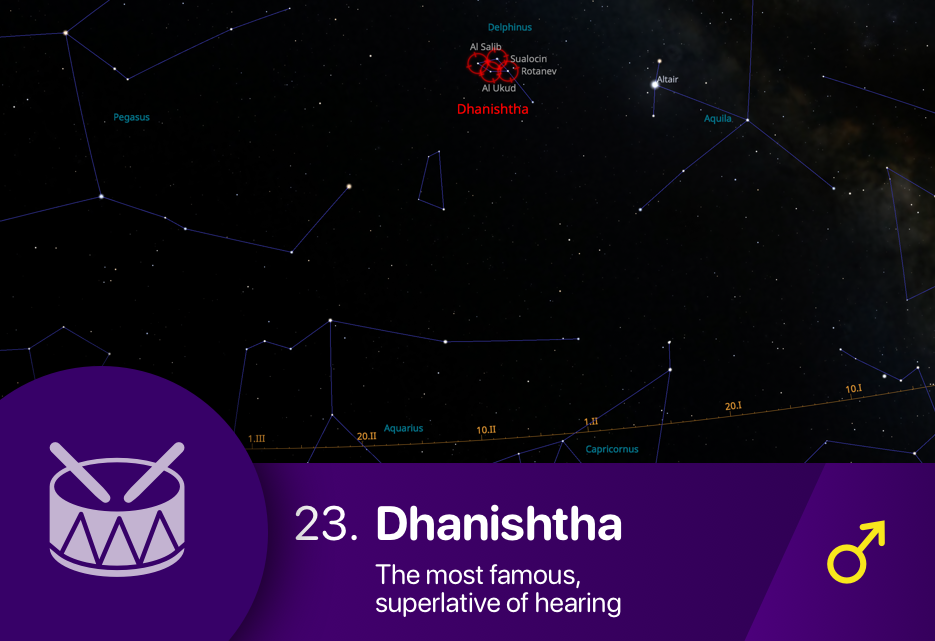
| Name | The most famous, superlative of hearing |
| Ruler | Mars |
| Symbol | Drum, flute |
| Also | Symphony, music, singing, charity |
| Deity | Eight vasus, deities of earthly abundance |
| Sidereal | 23º20 Capricorn – 6º40 Aquarius |
| Stars | α “Sualocin”, Rotanev, Al Ukud, Al Salib of Delphinus |
| Energy | Mars and Saturn–Uranus |
| Qualities | Active vision of higher realms, knowledge of the hidden, compassion, social justice, ambitions becoming obstacles, material pursuits turning greed, ruthless and cold |
24. Shatabhisha
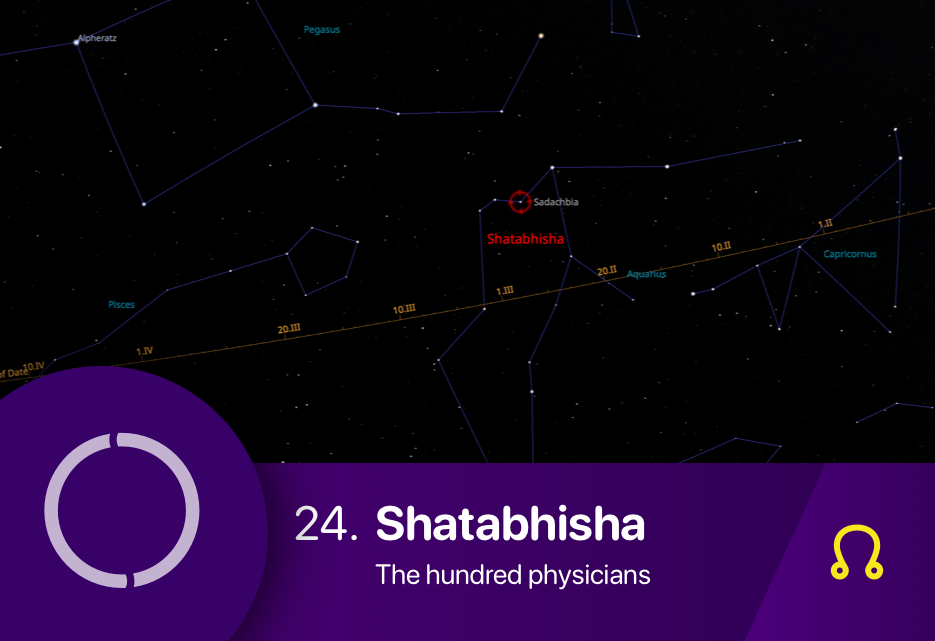
| Name | The hundred physicians |
| Ruler | Rahu (North Node) |
| Symbol | Empty circle, hundred flowers or stars |
| Also | Regal, king-like, veiled, secluded |
| Deity | Varuna, god of cosmic waters, sky and earth |
| Sidereal | 6º40 – 20º Aquarius |
| Stars | γ “Sadachbia” of Aquarius |
| Energy | North Node and Saturn–Uranus |
| Qualities | Higher knowledge, healing potential, vitality, independence, exclusivity, scepticism, harsh manners, isolation, loneliness |
25. Purva Bhadrapada
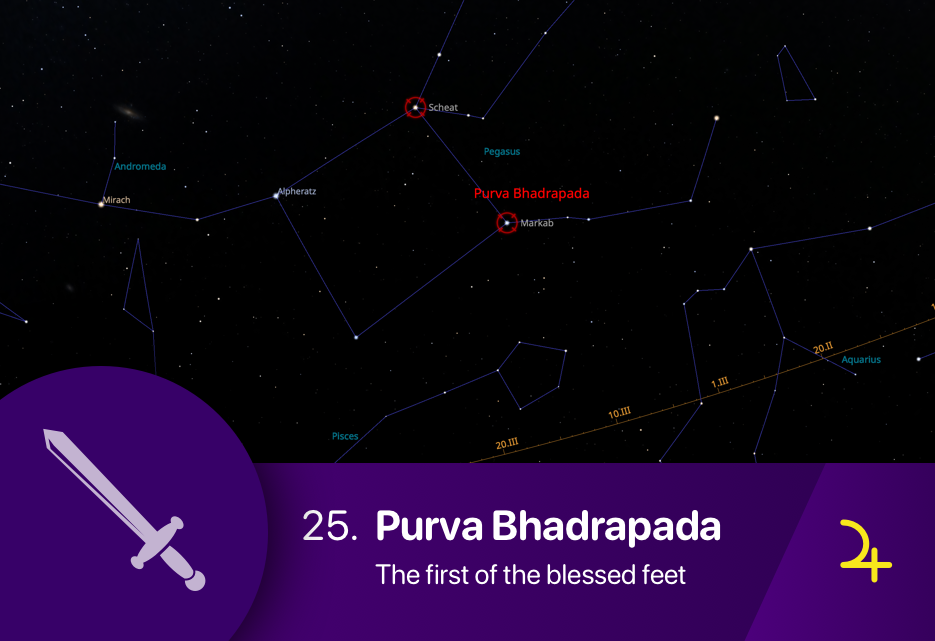
| Name | The first of the blessed feet |
| Ruler | Jupiter |
| Symbol | Swords or two front legs of bed (or funeral cot), man with two faces |
| Also | Burning, scorching pair |
| Deity | Aja Ekapada, one-footed goat |
| Sidereal | 20º Aquarius – 3º20 Pisces |
| Stars | α “Markab” and β “Scheat” of Pegasus |
| Energy | Jupiter and Uranus |
| Qualities | Original, eccentric, out-of-the-box visionaries, articulated and convincing, future oriented, mavericks, rebellious, critical, highly strung nervous system |
26. Uttara Bhadrapada
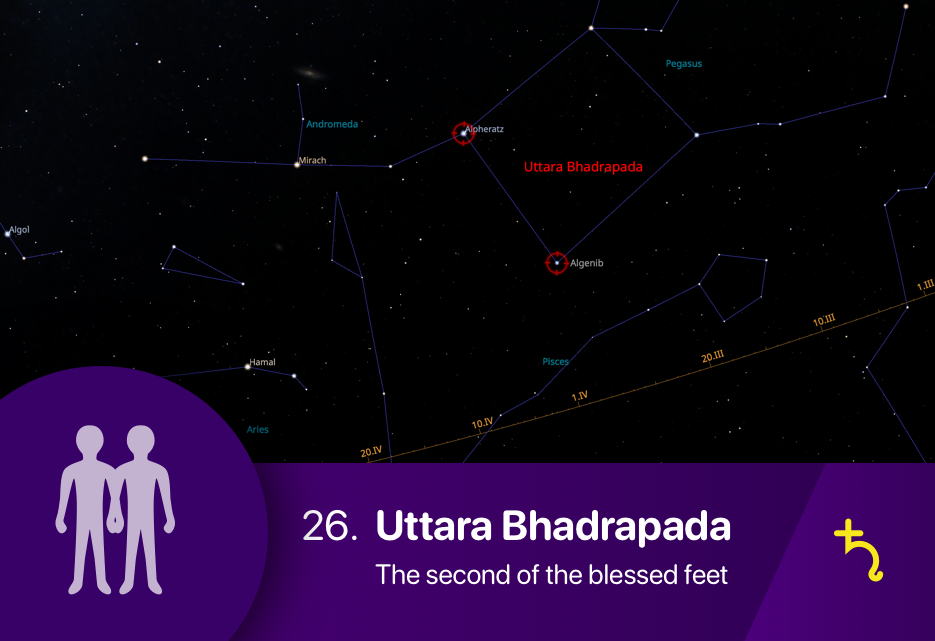
| Name | The second of the blessed feet |
| Ruler | Saturn |
| Symbol | Twins, back legs of bed (or funeral cot) |
| Also | Burning, scorching pair |
| Deity | Ahirbudhnya, dragon of the deep sea |
| Sidereal | 3º20 – 16º40 Pisces |
| Stars | γ “Algenib” of Pegasus and α “Alpheratz” of Andromeda |
| Energy | Saturn and Jupiter–Neptune |
| Qualities | Affinity with cosmos, spirituality, deep and expansive, idealistic, peaceful, lack of incarnation, indecisiveness, chaotic, substance addiction |
27. Revati
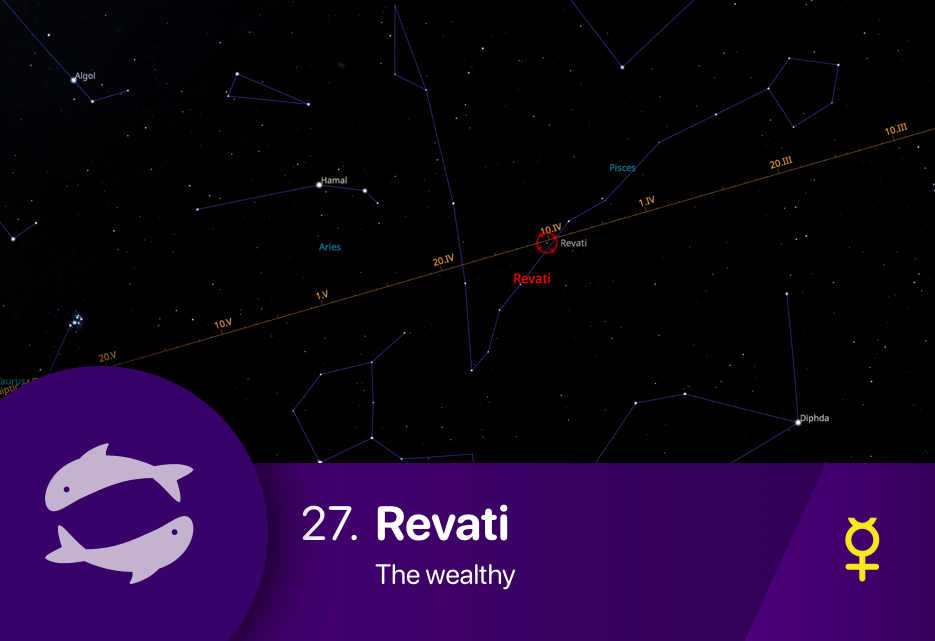
| Name | The wealthy |
| Ruler | Mercury |
| Symbol | Fish or pair of fish, drum |
| Also | Prosperous intuition |
| Deity | Pushan, the nurturer |
| Sidereal | 16º40 – 30º Pisces |
| Stars | ζ “Revati” of Pisces |
| Energy | Mercury and Jupiter–Neptune |
| Qualities | Inspired visionary, poetic and creative gifts, compassion and empathy, messy relationships, immaturity, naïveté, sense of irrelevance and inferiority, difficulties with self-identification |
Abhijit
The Abhijit nakshatra does not belong to the standard 27 nakshatras. It is the remnant of the ancient 28 nakshatra system. Abhijit enjoys a special popular attention for perhaps purely nostalgic reasons. There has to be something “extra special” after all. Abhijit is the 22nd nakshatra of the 28 nakshatra system.
From the experiential sky gazing standpoint Abhijit isn’t that prominent or active as it is based on the asterism of the star Vega of the constellation of Lyra that is exceedingly far from the path travelled by the Moon. The ecliptic latitude of Vega is about 62º and the Moon never ventures further than just a few degrees from the ecliptic plane, its maximum inclination is 5.30º
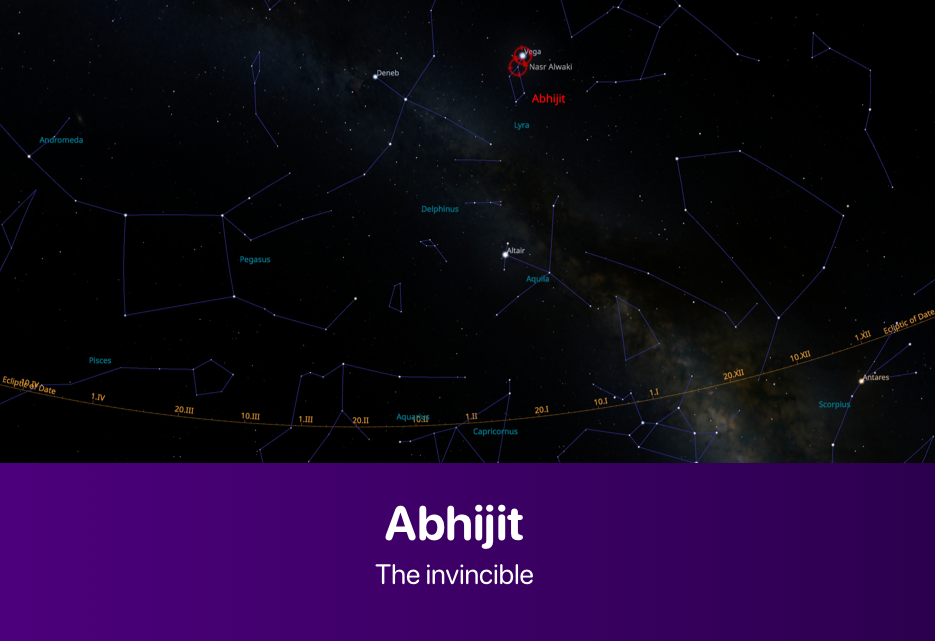
Notice how much the Abhijit asterism image had to be zoomed out compared to other nakshatra images in order to fit Vega into the view.
When mapped onto the standard 27 nakshatras, the boundaries of Abhijit overlap with the last quarter of Uttara Ashadha (#21) and extend to the first 1/15th segment of Shravana (#22).

The Nakshatras calculator
Track the nakshatras (lunar mansions) of the Moon and other planets of astrological chart using a Home Screen widget and an app extension. Explore the add-on…
3 Comments
SAMKARAM astrologer
Good and useful to astrologers.
Sergio Rosero
I like your style of presenting information! Thank you!
Lu Alta Stehman
First time I’ve been introduced to this, I find it fascinating and look forward to learning its use in natal and transit charts. I need to learn the pronunciation as well🤭